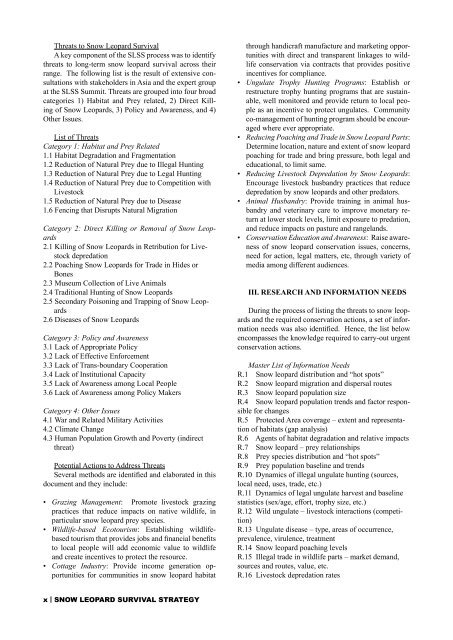Snow Leopard Survival Strategy - Panthera
Snow Leopard Survival Strategy - Panthera
Snow Leopard Survival Strategy - Panthera
Create successful ePaper yourself
Turn your PDF publications into a flip-book with our unique Google optimized e-Paper software.
Threats to <strong>Snow</strong> <strong>Leopard</strong> <strong>Survival</strong><br />
A key component of the SLSS process was to identify<br />
threats to long-term snow leopard survival across their<br />
range. The following list is the result of extensive consultations<br />
with stakeholders in Asia and the expert group<br />
at the SLSS Summit. Threats are grouped into four broad<br />
categories 1) Habitat and Prey related, 2) Direct Killing<br />
of <strong>Snow</strong> <strong>Leopard</strong>s, 3) Policy and Awareness, and 4)<br />
Other Issues.<br />
List of Threats<br />
Category 1: Habitat and Prey Related<br />
1.1 Habitat Degradation and Fragmentation<br />
1.2 Reduction of Natural Prey due to Illegal Hunting<br />
1.3 Reduction of Natural Prey due to Legal Hunting<br />
1.4 Reduction of Natural Prey due to Competition with<br />
Livestock<br />
1.5 Reduction of Natural Prey due to Disease<br />
1.6 Fencing that Disrupts Natural Migration<br />
Category 2: Direct Killing or Removal of <strong>Snow</strong> <strong>Leopard</strong>s<br />
2.1 Killing of <strong>Snow</strong> <strong>Leopard</strong>s in Retribution for Livestock<br />
depredation<br />
2.2 Poaching <strong>Snow</strong> <strong>Leopard</strong>s for Trade in Hides or<br />
Bones<br />
2.3 Museum Collection of Live Animals<br />
2.4 Traditional Hunting of <strong>Snow</strong> <strong>Leopard</strong>s<br />
2.5 Secondary Poisoning and Trapping of <strong>Snow</strong> <strong>Leopard</strong>s<br />
2.6 Diseases of <strong>Snow</strong> <strong>Leopard</strong>s<br />
Category 3: Policy and Awareness<br />
3.1 Lack of Appropriate Policy<br />
3.2 Lack of Effective Enforcement<br />
3.3 Lack of Trans-boundary Cooperation<br />
3.4 Lack of Institutional Capacity<br />
3.5 Lack of Awareness among Local People<br />
3.6 Lack of Awareness among Policy Makers<br />
Category 4: Other Issues<br />
4.1 War and Related Military Activities<br />
4.2 Climate Change<br />
4.3 Human Population Growth and Poverty (indirect<br />
threat)<br />
Potential Actions to Address Threats<br />
Several methods are identified and elaborated in this<br />
document and they include:<br />
• Grazing Management: Promote livestock grazing<br />
practices that reduce impacts on native wildlife, in<br />
particular snow leopard prey species.<br />
• Wildlife-based Ecotourism: Establishing wildlifebased<br />
tourism that provides jobs and financial benefits<br />
to local people will add economic value to wildlife<br />
and create incentives to protect the resource.<br />
• Cottage Industry: Provide income generation opportunities<br />
for communities in snow leopard habitat<br />
through handicraft manufacture and marketing opportunities<br />
with direct and transparent linkages to wildlife<br />
conservation via contracts that provides positive<br />
incentives for compliance.<br />
• Ungulate Trophy Hunting Programs: Establish or<br />
restructure trophy hunting programs that are sustainable,<br />
well monitored and provide return to local people<br />
as an incentive to protect ungulates. Community<br />
co-management of hunting program should be encouraged<br />
where ever appropriate.<br />
• Reducing Poaching and Trade in <strong>Snow</strong> <strong>Leopard</strong> Parts:<br />
Determine location, nature and extent of snow leopard<br />
poaching for trade and bring pressure, both legal and<br />
educational, to limit same.<br />
• Reducing Livestock Depredation by <strong>Snow</strong> <strong>Leopard</strong>s:<br />
Encourage livestock husbandry practices that reduce<br />
depredation by snow leopards and other predators.<br />
• Animal Husbandry: Provide training in animal husbandry<br />
and veterinary care to improve monetary return<br />
at lower stock levels, limit exposure to predation,<br />
and reduce impacts on pasture and rangelands.<br />
• Conservation Education and Awareness: Raise awareness<br />
of snow leopard conservation issues, concerns,<br />
need for action, legal matters, etc, through variety of<br />
media among different audiences.<br />
III. RESEARCH AND INFORMATION NEEDS<br />
During the process of listing the threats to snow leopards<br />
and the required conservation actions, a set of information<br />
needs was also identified. Hence, the list below<br />
encompasses the knowledge required to carry-out urgent<br />
conservation actions.<br />
Master List of Information Needs<br />
R.1 <strong>Snow</strong> leopard distribution and “hot spots”<br />
R.2 <strong>Snow</strong> leopard migration and dispersal routes<br />
R.3 <strong>Snow</strong> leopard population size<br />
R.4 <strong>Snow</strong> leopard population trends and factor responsible<br />
for changes<br />
R.5 Protected Area coverage – extent and representation<br />
of habitats (gap analysis)<br />
R.6 Agents of habitat degradation and relative impacts<br />
R.7 <strong>Snow</strong> leopard – prey relationships<br />
R.8 Prey species distribution and “hot spots”<br />
R.9 Prey population baseline and trends<br />
R.10 Dynamics of illegal ungulate hunting (sources,<br />
local need, uses, trade, etc.)<br />
R.11 Dynamics of legal ungulate harvest and baseline<br />
statistics (sex/age, effort, trophy size, etc.)<br />
R.12 Wild ungulate – livestock interactions (competition)<br />
R.13 Ungulate disease – type, areas of occurrence,<br />
prevalence, virulence, treatment<br />
R.14 <strong>Snow</strong> leopard poaching levels<br />
R.15 Illegal trade in wildlife parts – market demand,<br />
sources and routes, value, etc.<br />
R.16 Livestock depredation rates<br />
x | SNOW LEOPARD SURVIVAL STRATEGY
















